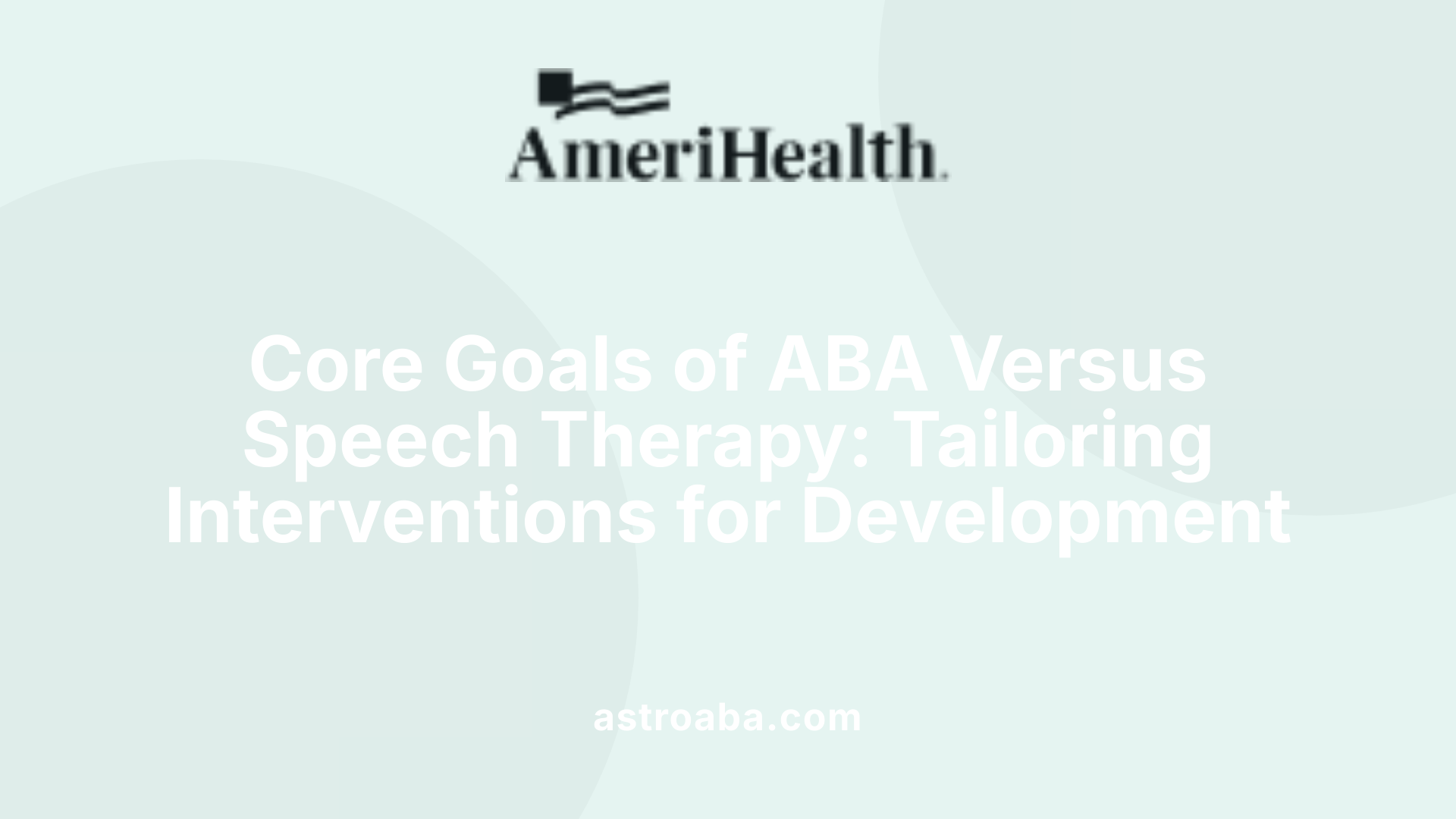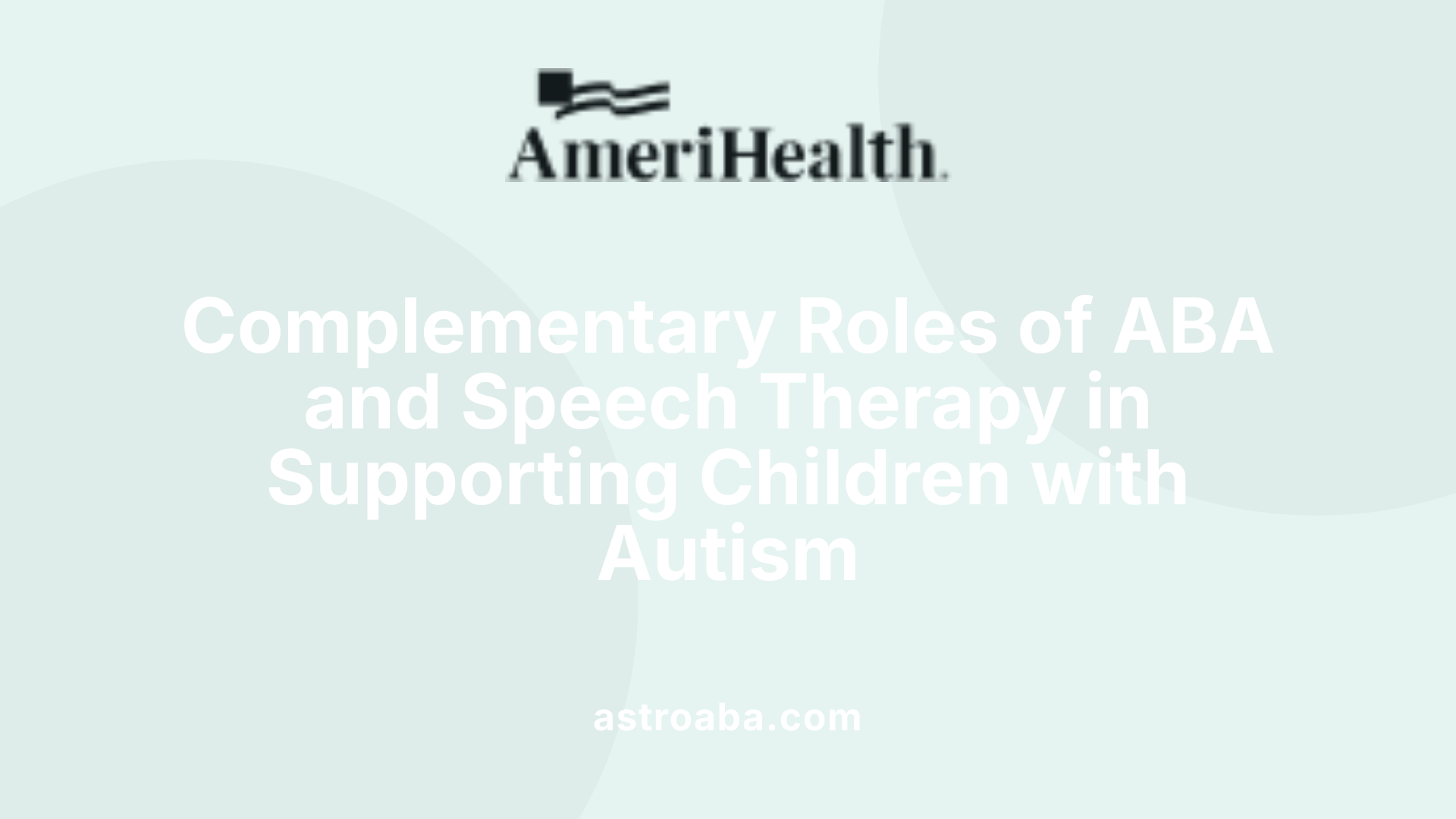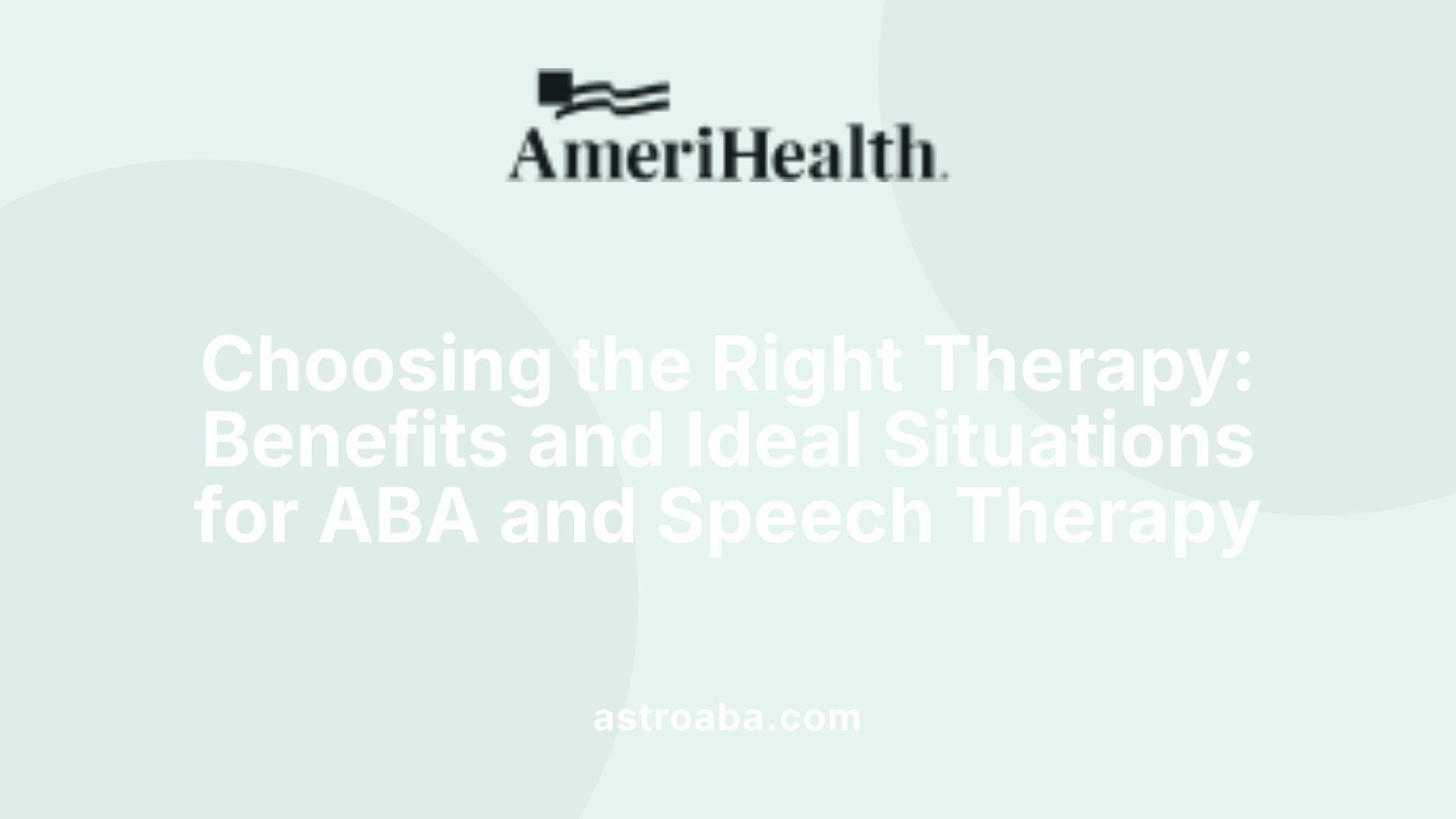What Are the Key Differences Between ABA Therapy and Speech Therapy?
Deciphering Autism Support: Comparing ABA and Speech Therapy Insights

Understanding Autism Interventions: Divergent Paths Toward Communication and Behavior
Children with autism often require a multifaceted approach to address their unique communication and behavioral needs. Among the most prominent therapies are Applied Behavior Analysis (ABA) and speech therapy. While both aim to improve functioning and quality of life, they utilize different principles, techniques, and objectives. This article explores the key differences between ABA therapy and speech therapy, providing clarity for families, caregivers, and professionals to make informed decisions tailored to individual needs.
Fundamental Principles and Focus Areas

What are the fundamental differences between ABA therapy and speech therapy?
Applied Behavior Analysis (ABA) is rooted in the scientific principles of behavior analysis, primarily using techniques such as positive reinforcement, shaping, prompting, and fading. Its main goal is to modify a wide array of behaviors—social, daily living, and cognitive—by understanding how environmental factors influence actions. ABA assesses behavior systematically through the ABCs—antecedent, behavior, consequence—and develops individualized intervention plans focused on increasing desired behaviors and reducing challenging ones.
Conversely, speech therapy is delivered by licensed speech-language pathologists (SLPs) and concentrates specifically on communication difficulties. Its core aim is to improve speech articulation, language comprehension, social communication, and oral motor skills. Techniques include using visual aids, social stories, augmentative and alternative communication (AAC) devices, and exercises to strengthen oral muscles.
While both therapies aim to improve functional skills, ABA’s broader scope encompasses behavioral patterns, social skills, and independence, often involving more structured, repetitive sessions with measurable goals. Speech therapy zeroes in on language and speech mechanics, offering flexible, relationship-based interventions attuned to each child's unique communication style.
In practice, these therapies often complement each other when working with children with autism. ABA programs might teach requesting behaviors and social skills, which speech therapists can then help develop into natural language use. Both approaches are data-driven but differ significantly in methods and theoretical focus, emphasizing how behavioral science and communication science uniquely contribute to developmental progress.
Goals, Techniques, and Applications

What are the specific objectives of ABA and speech therapy?
ABA therapy aims to develop and reinforce adaptive behaviors, including social skills, communication, daily living skills, and reducing maladaptive behaviors. Its primary goal is to improve independence and functional skills through systematic behavior modification. Meanwhile, speech therapy targets enhancing all aspects of communicative ability—speech clarity, language comprehension, verbal expression, social cues, and alternative communication modes like AAC devices.
Both therapies strive to support meaningful interaction and better quality of life. ABA often focuses on ensuring behaviors serve functional purposes, while speech therapy emphasizes effective and socially appropriate communication.
What common techniques are used in each therapy?
In ABA therapy, common methods include Discrete Trial Training (DTT), which involves repeated, structured teaching trials; Functional Communication Training, teaching children to replace problematic behaviors with functional requests; Incidental Teaching, which capitalizes on naturalistic teaching moments; and Joint Attention Activities to foster social engagement.
Speech therapy employs techniques like modeling correct sounds and language use, using visual aids such as picture boards, employing social stories to teach social language, articulation exercises to improve speech sounds, and the integration of AAC systems for individuals with limited verbal skills. Play-based activities and gestures are also widely used to facilitate engagement.
Both therapies frequently incorporate reinforcement—praise, rewards, or access to preferred items—to motivate and encourage desired behaviors or communication attempts.
In which settings are these therapies usually provided?
ABA therapy is typically delivered in various environments, including homes, schools, and clinics, with programs often involving intensive schedules, sometimes 20 to 40 hours per week. Its structured nature makes it suitable for both individual and group settings.
Speech therapy sessions are customized and can be held in clinics, schools, or at home, generally lasting shorter periods—about 1 to 2 hours per session—and often scheduled multiple times a week. Its flexible approach allows for integration into daily routines and social activities.
When combined, these therapies provide comprehensive support. Collaboration often involves sharing progress data and adapting strategies to integrate communication goals within behavioral frameworks, enhancing skill generalization and effectiveness.
Addressing Communication and Behavioral Challenges
How do ABA therapy and speech therapy each address communication and behavioral challenges?
ABA (Applied Behavior Analysis) therapy primarily focuses on changing and reducing problematic behaviors by reinforcing positive responses and developing functional skills. Techniques like shaping, which involves reinforcing successive approximations of a desired behavior, and manding, where a child learns to request for items or activities, are central to ABA. These methods promote social interaction and independence by encouraging appropriate behaviors and reducing maladaptive actions, based on thorough data collection and individualized plans that modify the environment to foster learning.
On the other hand, speech therapy directly targets communication deficits. It aims to improve both verbal and nonverbal skills using approaches like articulation therapy for speech clarity, language therapy to expand vocabulary and comprehension, and augmentative and alternative communication (AAC) systems for those with limited speech. Shaping in speech therapy involves gradually refining pronunciation or language use.
When used together, ABA and speech therapy offer a comprehensive approach. ABA helps manage behavioral issues that may hinder learning and social participation, while speech therapy builds expressive and receptive language. Collaboration between therapists ensures that interventions reinforce each other, leading to better generalization of skills across different environments. Both therapies often involve parents, who are trained to implement reinforcement strategies at home, supporting cohesive development in behavior and communication.
Appropriate Therapy Selection for Specific Needs
Which therapy is more appropriate for specific needs, especially in autism intervention?
Choosing the right therapy for a child with autism is a highly individualized process. It depends on the child's particular strengths, challenges, and developmental profile.
Applied Behavior Analysis (ABA) is often recommended when children exhibit significant behavioral challenges or delays across multiple areas such as social skills, daily living, and communication. It uses structured techniques like reinforcement, prompting, and data-driven assessments to teach new skills and reduce problematic behaviors.
On the other hand, speech therapy is especially beneficial for children struggling with speech and language issues. This includes difficulties with articulation, understanding, expressive language, or social communication. Speech-language pathologists use personalized strategies like picture cues, sign language, and language modeling to improve communication.
In many cases, combining both therapies yields the best outcomes. This integrated approach allows for addressing behavioral, communication, and social difficulties simultaneously, promoting more holistic development.
Ultimately, a comprehensive assessment by qualified professionals helps determine the most suitable intervention plan. These assessments evaluate the child's strengths and needs, guiding the choice of therapy or the combination of therapies that will facilitate meaningful progress.
Key Roles and Objectives of Each Therapy

What roles and objectives do ABA therapy and speech therapy have in supporting children with autism or communication difficulties?
ABA therapy and speech therapy are both essential in assisting children with autism and related communication concerns. They often work together to provide a well-rounded approach tailored to individual needs.
ABA (Applied Behavior Analysis) aims to increase adaptive, functional behaviors. It uses proven methods like positive reinforcement to teach social skills, language, and self-care routines. ABA also addresses problematic behaviors by understanding their functions and systematically modifying them, fostering independence and social integration.
Speech therapy, delivered by trained speech-language pathologists, focuses on improving verbal and non-verbal communication. It works to enhance speech clarity, vocabulary, comprehension, and social language skills. Various tools such as picture boards, gestures, and AAC devices are employed to support effective communication.
Collaborative efforts between ABA and speech therapy help children apply learned skills across different environments like home and school. This synergy allows for seamless development in social interactions, language, and behavioral independence.
By integrating these therapies, professionals can set aligned goals and share insights on behavior and communication patterns. Such teamwork ensures comprehensive progress, enabling children to better navigate social settings and daily activities. Overall, both therapies serve as complementary strategies that help children reach their full potential in communication and social functioning.
Benefits and Effective Situations for Each Therapy

What are the benefits and most effective situations for using ABA therapy versus speech therapy?
Applied Behavior Analysis (ABA) therapy offers significant benefits in teaching new skills, reducing problematic behaviors, and improving social and adaptive functioning. It is particularly effective for children with autism spectrum disorder (ASD) by applying scientifically validated strategies such as positive reinforcement, systematic behavior analysis, and individualized plans. These techniques help enhance communication, daily living skills, and social interactions. ABA is especially useful when behavior modification and skill acquisition are priorities, covering areas from self-care to social engagement.
On the other hand, speech therapy specializes in improving speech clarity, language comprehension, and overall communication abilities. It is crucial for individuals with speech and language delays, articulation issues, or social communication challenges. This therapy involves activities like articulation exercises, language modeling, and the use of augmentative and alternative communication (AAC) tools. Speech therapy is vital for helping individuals express themselves effectively and understand others.
Combining both approaches creates a comprehensive support system. ABA can address behavioral issues that may interfere with communication, while speech therapy can develop the language skills necessary for social interaction. Collaboration often involves using alternative methods like sign language, picture boards, and social stories.
The choice of therapy depends heavily on individual needs, developmental goals, and early intervention. Generally, initiating intensive therapies early—often around ages 2 to 4—can improve long-term outcomes. Tailoring interventions to the child's specific profile ensures the best chance for meaningful progress across behavioral and communication domains.
Empowering Families with Knowledge
Understanding the distinct roles, goals, and techniques of ABA therapy and speech therapy enables families and professionals to make informed, personalized decisions for children with autism or communication difficulties. Combining these therapies often yields the best outcomes, fostering development across behavioral, social, and communication domains. By tailoring interventions to each child's unique profile and emphasizing collaborative, evidence-based practices, caregivers can support meaningful progress and improved quality of life.
References
- ABA Therapy vs Speech Therapy for ASD: Which is Better for My ...
- ABA and Speech Therapy: Comparing Two Therapeutic Concepts
- OT, PT, Speech vs. ABA: Early Intervention | MPG
- Understanding Speech Therapy & ABA Terms - TherapyWorks
- Speech Language Pathology vs. BCBA: What's the Difference?
- When SLP Meets ABA - The ASHA Leader
- ABA Therapy vs. Speech Therapy: Which is More Effective?
- Understanding ABA vs. Speech Therapy: What's the Difference?
- The Truth about ABA & Speech-Language Therapy
- ABA vs Speech Therapy
Recent articles

The Role of Prompting and Fading in ABA Therapy Programs
Enhancing Autism Interventions Through Systematic Support Reduction

The Role of ABA Therapy in Supporting Community Participation
Enhancing Lives Through Community-Focused ABA Interventions

The Role of ABA Therapy in Encouraging Initiative and Motivation
Unlocking Potential: How ABA Empowers Children to Take Initiative

How ABA Therapy Helps Children Develop Initiation and Motivation
Unlocking Potential: The Power of ABA in Fostering Child Independence

How ABA Therapy Encourages Participation in Cooperative Group Activities
Fostering Social Skills Through ABA Interventions

How ABA Therapy Supports Independent Task Initiation in Children
Empowering Children to Begin with Confidence

How ABA Therapy Helps Children Build Resilience in Challenging Situations
Building Emotional Strength Through ABA Therapy

The Impact of ABA Therapy on Reducing Anxiety in Social Settings
Transforming Social Experiences: How ABA Therapy Eases Autism-Related Anxiety

Strategies for Teaching Self-Monitoring Through ABA
Empowering Independence: Techniques to Foster Self-Monitoring with ABA

The Benefits of Combining ABA with Speech and Language Therapy
Integrating Treatment Approaches to Maximize Developmental Progress

Strategies for Teaching Cooperative Problem-Solving Through ABA
Enhancing Collaborative Skills with ABA: Proven Strategies and Techniques

How ABA Therapy Encourages Independent Participation in Daily Tasks
Empowering Autonomy: How ABA Therapy Builds Independence in Daily Life

Creating an Effective Learning Environment at Home for ABA Therapy
Building a Supportive Home Environment for ABA Success

How ABA Therapy Encourages Following Safety Rules at Home and School
Empowering Children with Autism to Follow Essential Safety Rules

How ABA Therapy Encourages Communication Using Gestures and Signs
Enhancing Social Skills with Targeted Gesture Teaching

Common ABA Therapy Techniques for Reducing Aggression
Innovative Strategies in ABA to Minimize Aggressive Behaviors

How ABA Therapy Encourages Communication Using Gestures and Signs
Unlocking the Power of Gestures and Signs in Autism Therapy

How ABA Therapy Encourages Appropriate Social Greetings
Enhancing Social Skills Through Evidence-Based Interventions

Addressing Social Anxiety Using ABA-Based Techniques
Harnessing ABA to Alleviate Social Anxiety

Famous Politicians With Autism
Celebrating Neurodiversity: Insights into Autism and Notable Figures

How ABA Therapy Can Help with Anxiety in Children with Autism
Unlocking Emotional Well-Being: The Power of ABA in Managing Autism-Related Anxiety

The Impact of ABA Therapy on School Success
Enhancing Educational Outcomes with Systematic Interventions

The Importance of Social Stories in ABA Therapy
Harnessing Social Stories to Enhance Social Skills in Autism Interventions

Mild Autism
Understanding the Nuances of Mild Autism

What Are Functional Behavior Assessments (FBA) in ABA Therapy?
Unlocking the Secrets Behind Behavior: The Power of FBAs in ABA

Early Signs Of Autism In Babies And Kids
Recognizing Early Indicators to Support Developmental Health

How to Find Funding for ABA Therapy Services
Unlocking Funding Opportunities for Autism Treatments

How to Help a Child with Autism Transition to ABA Therapy
Supporting Children Through Transition Phases in ABA Therapy

Do Autistic People Get Injured More?
Examining Injury Risks in Individuals with Autism Spectrum Disorder

How ABA Therapy Can Help with Executive Functioning Challenges
Unlocking Skills: The Impact of ABA on Executive Functioning in Autism

What is the Premack Principle in ABA Therapy?
Unlocking Motivation: The Power of the Premack Principle in ABA Therapy

Low-Functioning Autism
Understanding the Challenges and Supports for Low-Functioning Autism

Low-Functioning Autism
Understanding the Challenges and Supports for Low-Functioning Autism

How ABA Therapy Can Help with Playdates and Social Events
Unlocking Social Success: How ABA Therapy Facilitates Playdates and Community Engagement

How ABA Therapy Can Address Impulse Control Issues
Mastering Behavioral Growth: The Power of ABA in Impulse Control

Book, Movie, and TV Characters on the Autism Spectrum
Enhancing Understanding Through Fictional Portrayals

Book, Movie, and TV Characters on the Autism Spectrum
Enhancing Understanding Through Fictional Portrayals

The Role of Visual Supports in ABA Therapy
Enhancing Autism Interventions with Visual Supports

What Is Pervasive Developmental Disorder
Understanding the Spectrum of Developmental Challenges

How ABA Therapy Helps with Emotional Regulation
Empowering Emotional Resilience in Children with Autism

What is Task Analysis in ABA Therapy?
Unveiling the Foundations of Task Analysis in ABA Therapy

How ABA Therapy Can Improve Play Skills
Unlocking Growth: The Power of ABA in Enhancing Play Skills

Air Pollution and Autism
Unveiling the Environmental Impact on Developing Minds

How ABA Therapy Can Help with Bullying Prevention
Building Respect and Resilience Through ABA

How ABA Therapy Can Be Used to Teach Problem-Solving Strategies
Empowering Individuals with Autism Through Targeted Problem-Solving Skills

Can Autistic People Work?
Unlocking Potential: The Realities of Employment for Autistic Individuals

How ABA Therapy Can Help with Homework and Academics
Empowering Academic Success with ABA Therapy

Common Myths About ABA Therapy Debunked
Unmasking Autism Treatment: The Truth About ABA Therapy

Does Aluminum Cause Autism?
Unraveling the Link: Aluminum and Autism Spectrum Disorder

How ABA Therapy Can Support Emotional Expression and Understanding
Unlocking Emotional Growth in Autism Through ABA Therapy

The Role of ABA Therapy in Helping Children Learn Road Safety
Empowering Safe Journeys: How ABA Therapy Fosters Road Safety Skills in Children

The Role of Group ABA Therapy in Social Development
Enhancing Social Skills Through Collective Strategies

What Is Autistic Burnout?
Understanding the Hidden Struggle of Autistic Burnout

How Do You Get An Autistic Child To Keep Their Shoes On?
Mastering Comfort and Compliance with Shoes for Autistic Children

The Role of ABA Therapy in Addressing Food Aversions and Picky Eating
Transforming Mealtimes: How ABA Therapy Supports Children with Autism

How ABA Therapy Can Assist in Reducing Perfectionism and Anxiety
Harnessing Behavioral Science to Ease Perfectionism and Anxiety

What Is Defeat Autism Now?
Unveiling the Roots and Realities of the DAN Movement

How ABA Therapy Can Help Children Develop Conflict Resolution Skills
Building Bridges: Empowering Children with Conflict Resolution Skills through ABA

OCD vs. Autism
Unraveling the Complex Relationship Between OCD and Autism

Temper Tantrums A Sign Of Autism
Understanding the Complex Relationship Between Temper Tantrums and Autism Spectrum Disorder

How to Pass the BCBA Exam
Your Ultimate Guide to Success in the BCBA Exam

Autism and Addiction's Close Connection
Unraveling the Complex Interplay Between Autism and Substance Use

Autism Facial Expressions
Decoding Emotions: The Complex World of Facial Expressions in Autism

How ABA Therapy Can Help Reduce Anxiety Around Doctor and Dentist Visits
Transforming Medical Experiences for Children with Autism

How ABA Therapy Can Help with Navigating Social Media Responsibly
Empowering Safe Online Engagement for Children with Autism through ABA

How to Choose an Autism Charity
Navigating the Spectrum of Support: A Guide to Selecting the Right Autism Charity

What is Precision Teaching in ABA Therapy?
Harnessing Data-Driven Strategies for Skill Mastery

Autism and Obesity
Understanding the Overlap: Autism and the Rising Concern of Obesity

Individualized Education Programs (IEPs) for Autism
Supporting Success: A Comprehensive Guide to IEPs for Children with Autism

How to Integrate ABA Therapy into Everyday Routines
Transforming Daily Life with ABA Strategies

What is Shaping in ABA Therapy?
Understanding the Core of Behavior Shaping in Autism Interventions

Autism vs. ADHD
Understanding the Distinction and Overlap of Neurodevelopmental Disorders

Is RBT Certification Worth It?
Unveiling the Value of RBT Certification in the Field of ABA

How Negative Reinforcement Works in ABA Therapy
Unlocking the Power of Negative Reinforcement in Behavioral Therapy

How to Advocate for ABA Therapy Services in Schools
Navigating Advocacy for School-Based ABA Therapy

How ABA Therapy Can Address Impulsivity in Children
Transforming Child Behavior: The Power of ABA Therapy Against Impulsivity

Understanding the Different Types of ABA Therapy Programs
Exploring the Spectrum of ABA Therapy Approaches

How ABA Therapy Can Address Regression in Autism
Understanding Regressive Autism and the Role of ABA Therapy

High Functioning Autism And Anger
Understanding Emotional Challenges in High-Functioning Autism

Autism and Puberty
Understanding Puberty in Autistic Youth: Challenges and Support Strategies

Challenging Autism Behavior Problems
Navigating the Complex Landscape of Autism-Related Behavioral Challenges

How ABA Therapy Can Help with Sleep Problems
Transforming Bedtime Routines with Evidence-Based Approaches

How ABA Therapy Can Help Improve Cooperation and Compliance
Fostering Respectful Engagement: The Role of ABA in Enhancing Cooperation and Compliance

Eating Disorders And Autism
Unraveling the Complex Relationship Between Autism and Eating Disorders

How Schedules of Reinforcement Work in ABA Therapy
Mastering Reinforcement Patterns to Foster Behavior Change

How to Incorporate ABA Therapy into a Homeschooling Program
Transforming Homeschooling with Evidence-Based Strategies

What Are the Most Common Misconceptions About ABA Therapy?
Unveiling the Truth Behind ABA Therapy: Myths vs. Facts

What is Demand Fading in ABA Therapy?
Demystifying Demand Fading in ABA Therapy

What Are ABA Assessments and How Do They Work?
Understanding the Foundations of ABA Assessments

What is an AAC Device for Autism?
Unlocking Communication: The Power of AAC Devices for Autism

How ABA Therapy Can Help Children Understand and Express Emotions
Enhancing Emotional Understanding Through Evidence-Based Interventions

How To Prevent Autism
Emerging Strategies to Reduce Autism Risk in Children

How ABA Therapy Can Improve Verbal and Nonverbal Communication
Unlocking Communication: The Power of ABA Therapy for Children with Autism

Natural Environment Teaching (NET): How It Helps with Skill Generalization
Unlocking Practical Learning in Natural Settings

What Is Play Therapy For Autism?
Unlocking the Potential of Play in Autism Therapy

How ABA Therapy Can Improve Fine and Gross Motor Skills
Enhancing Movement and Independence Through ABA Strategies

Calming Strategies For Kids With Autism
Understanding and Supporting Calmness in Children with Autism

Autism Evaluation
Comprehensive Insights into Autism Assessment and Diagnosis

How to Support Your Child's ABA Therapy at Home
Empowering Your Child’s Development at Home with ABA Support

Autism Prevalence Increases in Arizona
Rising Autism Rates Signal Changing Landscape in Arizona

